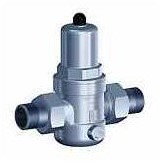Page 1 of 17 (395 results)
- Previous
- 1
- 2
- 3
- 4
- 5
- 6
- 7
- 8
- 9
- 10
- 11
- 12
- 13
- 14
- 15
- 16
- 17
- Next
Sort:
Sort:
Page 1 of 17 (395 results)
- Previous
- 1
- 2
- 3
- 4
- 5
- 6
- 7
- 8
- 9
- 10
- 11
- 12
- 13
- 14
- 15
- 16
- 17
- Next
Filter

Pressure relief valve (PRV)
A pressure relief valve ensures a constant pressure in an area of the system that operates at a pressure lower than the normal system pressure. A pressure reducing valve can normally be set for any desired downstream pressure within the design limits. Once the valve is set, the reduced pressure is maintained regardless of changes in supply pressure and variations in system load.
There are different designs and types of pressure control valves. The most common are the spring-loaded pressure relief valve and the pilot-controlled pressure relief valve.
Spring loaded pressure relief valve
The spring loaded pressure relief valve is widely used in pneumatic systems. It is also often called a pressure regulator. The valve simply uses spring pressure against a diaphragm to open the valve. At the bottom of the diaphragm, the diaphragm is pushed upwards by the outlet pressure of the regulator to close the pressure reducer. When the outlet pressure drops below the set value of the pressure reducing valve, the spring pressure overcomes the outlet pressure and forces the valve stem downwards, thus opening the pressure reducing valve. As the outlet pressure of the pressure reducing valve increases and the desired pressure approaches, the pressure under the diaphragm begins to overcome the spring pressure, forcing the valve stem upward and closing the pressure reducing valve. You can adjust the emphasis by rotating the adjusting screw, which varies the spring pressure against the diaphragm. This spring loaded pressure relief valve opens in the event of a diaphragm rupture.
Pilot-controlled pressure reducing valve
The operation of a pilot-controlled pressure relief valve consists of an adjustable control valve which regulates the working pressure of the valve and a main valve which reacts to the operation of the pilot valve (also known as the control valve).
The control valve of the pressure reducing valve consists of a bulkhead, a spring and an adjustment screw. The main valve consists of: a valve spindle and a spring. The fluid enters the inlet port under pressure from the main system and can flow freely through the valve and the exhaust port under all circumstances.
In the open position, the pressure in the reduced outlet port has not reached the pre-set operating pressure of the pressure reducing valve. The fluid pressure at the outlet port is therefore distributed over both ends of the spindle. When this pressure is equal, the spindle is hydraulically balanced. The spring around the spindle is a low tension spring and exerts only a slight downward force on the spindle. The main goal is to position the spindle and keep the opening at its maximum size.
As the pressure in the outlet port of the pressure reducing valve increases, this pressure is transferred through the passages to the chamber. This pressure also works on the control valve plate. When this pressure rises above the set operating pressure, it overcomes the force of the control valve spring and disengages the poppet valve. This allows liquid to flow through the drain port. Because the small passage restricts the flow to the chamber, the fluid pressure in the chamber drops. This causes a brief pressure difference over the valve spindle, allowing the fluid pressure acting on the lower part of the spindle to overcome the downward force of the spring. The coil is then forced upward until the pressure across the ends of the spindle is equalized. As the spindle moves upwards, it restricts the flow through the opening and reduces the pressure in the lowered pressure outlet. If the pressure in the outlet port continues to rise to a value above the pre-set pressure, the control valve will open again and the cycle will repeat. This allows the spindle to be placed higher up in the chamber, further reducing the size of the opening. The spindle can be placed in the chamber, further reducing the size of the opening. These cycles are repeated until the desired pressure in the outlet of the pressure reducer is maintained.
When the pressure in the outlet drops to a value below the preset pressure, the spring forces the spindle down, allowing more fluid to flow through the opening.
Pressure-reducing valves are available with different process connections and in different materials such as stainless steel, brass, PVC, PP and PVDF.
For pressure reducing valves for compressed air see also https://ebora.co.uk/pneumatics/air-care.html